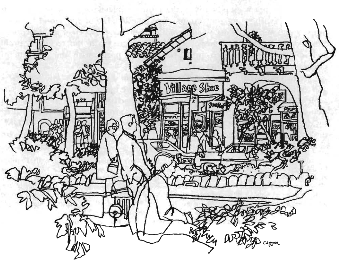Articles/Essays – Volume 05, No. 4
A Footnote to the Problem of Dating the First Vision
Both sides of the current debate over the date of the First Vision have tried to establish the time when members of the Smith family joined the Presbyterian church in Palmyra. The primary source for this is two volumes of “Session Records” of the Palmyra congregation. Unfortunately, volume one, which would probably give the exact date the Smiths joined, has been missing since at least 1932. The minutes of the sessions from March 3 through March 29 of 1830 in the second volume, however, do contain some interesting information.
The Reverend Wesley P. Walters uses this second volume simply to prove that members of the Smith family were members of “the local Palmyra church, and not some other presbyterian congregation in another town.”[1] Milton B. Backman, Jr. of B.Y.U. cites the same source for the same reason.[2]
My own research in these records did not uncover any information re garding the year in which the Smiths joined, but I did find some important things not pointed out by either Walters or Backman. Now, more than ever, L.D.S. historians are under the obligation of bringing to light as much in formation as possible concerning the Restoration. For this reason, the fol lowing synopsis of the pertinent sessions from volume two of the Palmyra “Session Records,” is offered.
On March 3, 1830 the session “met pursuant to notice,” and, among other things, “Resolved that the Reverend A. E. Campbell and H. Jessup be a committee to visit Hiram Smith, Lucy Smith, and Samuel Harrison Smith and report at the next meeting of session.”
[March 10] “The committee appointed to visit Hiram Smith, Lucy Smith, and Samuel Harrison Smith reported that they had visited them and received no satisfaction. They acknowledged that they had entirely neglected the ordinances of the church for the last eighteenth months and that they did not wish to unite with us any- more. Whereupon Resolved that they be cited to appear before the session on the 24th day of March inst., at 2 o’clock P.M. at this Meet- ing House to answer to the following charge to wit:
Neglect of public worship and the sacrament of the Lord’s Sup- per for the last eighteen months.”
This action was taken by the Rev. Alfred E. Campbell and Elders George Beckwith, Henry Jessup, Pelatiah West, and Newton Foster and witnessed by Harvey Shet, Levi Dagget, James Robinson, Robert W. Smith, and Frederick Sheffield.
[March 24] “Hiram Smith, Lucy Smith, and Samuel Harrison Smith not appearing pursuant to the citation served upon them by P. West—Resolved that they be again cited to appear before his session on Monday the 29th inst. At this place at 2 o’clock P.M.—and that P. West serve said citation.”
On March 29, 1830 “The persons before cited to wit—Hiram Smith, Lucy Smith, and Samuel Harrison Smith not appearing and the session having satisfactory evidence that the citation was duly served. Resolved that they be censured for their contumacy. Re- solved that George Beckwith manage their defense. The charge in the above case being fully sustained by the testimony of Henry Jessup, Harvey Shet, Robert W. Smith, and Frederick U. Sheffield. (In minutes of .. . [?] on file with the clerk.) The session after duly considering the matter were unanimously of opinion Hiram Smith, Lucy Smith, and Samuel Harrison Smith ought to be suspended—Resolved that Hiram Smith, Lucy Smith, and Samuel Harrison Smith be and they hereby are suspended from the Sacrament of the Lord’s Supper.”
Such was the ecclesiastical trial of members of the Prophet’s family. From this we can conclude, in addition to the fact that Lucy, Hiram, and Samuel Harrison were indeed members of the Palmyra congregation, that sometime during the translation of the Book of Mormon they had become inactive and that by early March of 1830 they were being charged with “Neglect of public worship and the Sacrament of the Lord’s Supper. . . .” We also know that they ignored two personally served citations and that on March 29 they were “suspended from the Sacrament of the Lord’s Supper.”
Lucy, Hiram, and Samuel’s inactivity in the Presbyterian Church was no doubt directly related to Joseph’s opinions. When they were contemplating joining with the Presbyterians, Joseph told his mother that “it would do us no injury to join them, that if we did, we should not continue with them long, for we were mistaken in them, and did not know the wickedness of their hearts.” Sometime later Joseph also said, “You look at Deacon Jessup, . . . and you hear him talk very piously. Well, you think he is a very good man. Now suppose that one of his poor neighbors should owe him the value of a cow, and that this poor man had eight little children; more over, that the should be taken sick and die, leaving his wife with one cow, but destitute of every other means of supporting herself and family—now I tell you, that Deacon Jessup, religious as he is, would not scruple to take the last cow from the poor widow and orphans in order to secure the debt, notwithstanding he himself had an abundance of everything.”[3]
[1] New Light on Mormon Origins From the Palmyra, N.Y. Revival, (Utah Christian Tract Society, La Mesa, California, 1969), p. 22, and also as part of a Roundtable discussion on “The Question of the Palmyra Revival,” Dialogue, 4 (Spring, 1969), p. 76.
[2] “Awakenings in the Burned-over District: New Light on the Historical Setting of the First Vision,” B.Y.U. Studies, 9 (Spring, 1969), p. 310.
[3] Lucy Mack Smith, History of Joseph Smith, (Salt Lake City, 1954), pp. 90-91.


 Back to full Issue
Back to full Issue

